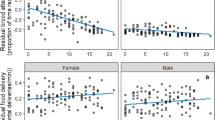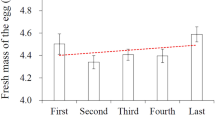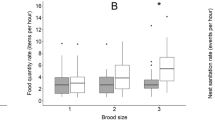Abstract
Extended post-fledging parental care is an important aspect of parental care in birds, although little studied due to logistic difficulties. Commonly, the brood is split physically (brood division) and/or preferential care is given to a subset of the brood by one parent or the other (care division). Among gulls and tern (Laridae), males and females generally share parental activities during the pre-fledging period, but the allocation of parental care after fledging is little documented. This study examined the behaviour of male and female roseate terns (Sterna dougallii) during the late chick-rearing and early post-fledging periods, and in particular the amount of feeds and the time spent in attendance given to individual chicks/fledglings. Pre-fledging parental care was biparental in all cases. Post-fledging parental care was dependent on the number of fledglings in the brood. Males and females continued biparental care in clutches with one surviving fledgling, while in two-fledgling clutches, males fed the A-fledgling while females fed the B-fledgling. Overall, there was no difference in attendance, only in feeds. This division of care may be influenced by the male only being certain of the paternity of the A-chick but not by chick sex.


Similar content being viewed by others
References
Ashmole NP, Tovar SH (1968) Prolonged parental care in royal terns and other birds. Auk 85:90–100
Barlow M (1998) Movements of Caspian terns (Sterna caspia) from a colony near Invercargill, New Zealand, and some notes on their behaviour. Notornis 45:193–220
Bridge ES, Jones AW, Baker AJ (2005) A phylogenetic framework for the terns (Sternini) inferred from mtDNA sequences: implications for taxonomy and plumage evolution. Mol Phyl Evol 35:459–469
Burger J (1980) The transition to independence and postfledging parental care in seabirds. In: Burger J, Olla BL, Winn HE (eds) Behavior of marine animals. Marine birds, vol 4. Plenum, New York
Cam E, Monnat J-Y, Hines JE (2003) Long-term fitness consequences of early conditions in the kittiwake. J Anim Ecol 72:411–424
Clutton-Brock TH (1991) The evolution of parental care. Princeton University Press, New Jersey
Cockburn A (2006) Prevalence of different modes of parental care in birds. Proc R Soc B 273:1375–1383
Feare CJ (1975) Post-fledging parental care in crested and sooty terns. Condor 77:368–370
Gochfeld M, Burger J, Nisbet ICT (1998) Roseate tern Sterna dougallii. In: Poole A, Gill F (eds) The birds of North America, no. 370. The birds of North America Inc, Philadelphia
González-Solís J, Sokolov E, Becker PH (2001) Courtship feedings, copulations and paternity in common terns. Anim Behav 61:1125–1132
Griggio M, Giuliano M, Marin G (2004) No evidence of extra-pair paternity in a colonial seabird, the common tern (Sterna hirundo). Ital J Zool 71:219–222
Hamer KC, Schreiber EA, Burger J (2002) Breeding biology, life histories, and life history–environment interactions in seabirds. In: Schreiber EA, Burger JA (eds) Biology of marine birds. CRC Press, Boca Raton
Kvarnemo C (2006) Evolution and maintenance of male care: is increased paternity a neglected benefit of care? Behav Ecol 17:144–148
Lack D (1968) Ecological adaptations for breeding in birds. Methuen, London
Lessells CM (2002) Parentally biased favouritism: why should parents specialize in caring for different offspring? Phil Trans R Soc Lond B 357:381–403
Ligon JD (1983) Cooperation and reciprocity in avian social systems. Am Nat 121:336–384
Ligon JD (1999) The evolution of avian breeding systems. Oxford University Press, Oxford
McLauglin RL, Montgomerie RD (1985) Brood division by Lapland longspurs. Auk 102:687–695
Møller AP, Birkhead TR (1993) Certainty of paternity covaries with paternal care in birds. Behav Ecol Sociobiol 33:361–368
Nisbet ICT (1981) Biological characteristics of the Roseate Tern Sterna dougallii. Unpublished report to the US Fish and Wildlife Service, Newton Corner
Nisbet ICT, Drury WH (1972) Measuring breeding success in common and roseate terns. Bird Banding 43:97–106
Nisbet ICT, Wingate DB, Szczys P (2010) Demographic consequences of a catastrophic event in the isolated population of common terns at Bermuda. Waterbirds 33:405–410
Radford AN, Ridley AR (2006) Recruitment calling: a novel form of extended parental care in altrical species. Curr Biol 16:1700–1704
Schwagmeyer PL, St. Clair RC, Moodie JD, Lamey TC, Schnell GD, Moodie MN (1999) Species differences in male parental care in birds: a re-examination of correlates with paternity. Auk 116:487–503
Shealer DA (1995) Male feeding and chick provisioning and their effects on breeding performance among known-age roseate terns at the Falkner Island Unit of the Stewart B. McKinney National Wildlife Refuge, Connecticut: 1997 research summary. Unpublished report to Little Harbor Laboratory, Inc., Guilford, CT
Shealer DA, Spendelow JA (2002) Individual foraging strategies of kleptoparasitic roseate terns. Waterbirds 25:436–441
Skutch AF (1976) Parent birds and their young. University of Texas Press, Austin
Slagsvold T (1997) Brood division in birds in relation to offspring size: sibling rivalry and parental control. Anim Behav 54:1357–1368
Spear LB, Ainley DG, Henderson RP (1986) Post-fledging parental care in the Western gull. Condor 88:194–199
Spendelow JA (1982) An analysiss of temporal variation in, and the effects of habitat modification on, the reproductive success of roseate terns. Colon Waterbird 5:18–31
Spendelow JA, Zingo JM (1997) Female roseate tern fledges a chick following the death of her mate during the incubation period. Colon Waterbird 20:552–555
Spendelow JA, Burger J, Nisbet ICT, Nichols JD, Hines JE, Hays H, Cormons GD, Gochfeld M (1994) Sources of variation in loss rates of colorbands applied to adult roseate terns (Sterna dougallii) in the western North Atlantic. Auk 111:881–887
Szczys P, Nisbet ICT, Hatch JJ, Kesseli RV (2001) Sex ratio bias at hatching and fledging in the roseate tern. Condor 103:385–389
Tarwater CE, Brawn JD (2008) Patterns of brood division and an absence of behavioral plasticity in a neotropical passerine. Behav Ecol Sociobiol 62:1441–1452
Vega LB, Graham JH, Millett JE, Richardson DS (2007) Extreme gender-based post-fledging brood division in the toc-toc. Behav Ecol 18:730–735
Wagner RH, Safina C (1989) Relative contribution of the sexes to chick feeding in roseate and common terns. Wilson Bull 101:497–500
Acknowledgments
We are grateful to D. Shealer and J. Zingo for their contributions to the set-up of this study and the Stewart B. McKinney N.W.R. for permission to work on Falkner Island. We are indebted to I.C.T. Nisbet for the idea for this project, P. Szczys for sexing the fledglings and S. Brault for analytical advice, and also to J. Arnold for encouragement and company, as well as D. Watson for support and comments on various drafts. This research was supported by the Blake Fund of the Nuttall Ornithological Club. Field studies were carried out in accordance with all relevant state and Federal regulations and licences.
Author information
Authors and Affiliations
Corresponding author
About this article
Cite this article
Watson, M.J., Spendelow, J.A. & Hatch, J.J. Post-fledging brood and care division in the roseate tern (Sterna dougallii). J Ethol 30, 29–34 (2012). https://doi.org/10.1007/s10164-011-0286-9
Received:
Accepted:
Published:
Issue Date:
DOI: https://doi.org/10.1007/s10164-011-0286-9




